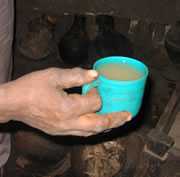Household Water Treatment & Safe Water Storage
In much of the world, community water systems do not exist. Approximately 780 million people do not have access to an improved drinking water source* 1. Household water treatment (treatment that happens at the point of water collection or use, rather than at a large, centralized location) improves water quality and reduces diarrheal disease in developing countries.
CDC’s Safe Water System

Photo courtesy of D. Lantagne
In areas where access to safe water, appropriate wastewater management, and adequate sewer systems is not feasible, certain programs, such as CDC's Safe Water System (SWS), can empower people to improve and protect the quality of their drinking water through simple, inexpensive technologies to treat and safely store water in their homes. The intervention consists of these steps:
- Point-of-use treatment of contaminated water
- Safe water storage
- Improved hygiene
- Behavior change techniques
Learn more about SWS household water treatment options.
* An improved water source is defined as water that is supplied through a household connection, public standpipe, borehole well, protected dug well, protected spring, or rainwater collection.
Additional Resources
General information, as well as technical information for smaller, community-based organizations on developing household water treatment and safe water storage programs, is available online.
- Bibliography of Point-of-Use Water Disinfection [PDF - 25 pages]
- Household Water Treatment and Safe Storage - World Health Organization
- Safe Water for the Community: A Guide for Establishing a Community-Based Safe Water System Program [PDF - 62 pages] *
* This guide can also be obtained in hard copy with a CD by sending an email to healthywater@cdc.gov.)
Reference
-
World Health Organization and UNICEF. Progress on Drinking Water and Sanitation: 2012 Update. United States: WHO/UNICEF Joint Monitoring Programme for Water Supply and Sanitation; 2012.
- Page last reviewed: December 17, 2015
- Page last updated: December 17, 2015
- Content source:


 ShareCompartir
ShareCompartir